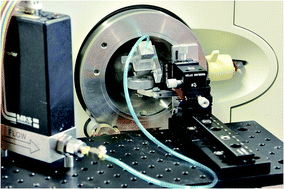当前位置:
X-MOL 学术
›
Anal. Methods
›
论文详情
Our official English website, www.x-mol.net, welcomes your
feedback! (Note: you will need to create a separate account there.)
A low-cost ambient desorption/ionization source for mass-spectrometry based on a dielectric barrier discharge
Analytical Methods ( IF 2.7 ) Pub Date : 2018-05-25 00:00:00 , DOI: 10.1039/c8ay00446c Jasmine S. Furter 1, 2, 3, 4 , Peter C. Hauser 1, 2, 3, 4
Analytical Methods ( IF 2.7 ) Pub Date : 2018-05-25 00:00:00 , DOI: 10.1039/c8ay00446c Jasmine S. Furter 1, 2, 3, 4 , Peter C. Hauser 1, 2, 3, 4
Affiliation

|
An ambient ionization source for mass-spectrometry is described. It is based on a plasma generated in helium by a dielectric barrier discharge using two external electrodes arranged axially on a fused silica tube. The plasma is created with a sinusoidal voltage source having an amplitude of 7 kilovolts and a frequency of 27 kilohertz. The plasma cell as well as the excitation circuitry were designed with simplicity in mind and both can easily be duplicated. The plasma source was characterized in terms of electronic properties and temperatures by using optical emission spectroscopy. Bands of the nitrogen second positive system at 357 nm were used for determination of the vibrational and rotational temperatures by fitting simulated to the experimental spectra with the software package Specair. With an excitation voltage of 7 kilovolts and a flow rate of 50 mL min−1, a vibrational temperature of approximately 5000 K and a rotational temperature of 300 K were determined. By using the Boltzmann plot method, the excitation temperature was determined to be around 2800 K. The performance of the ionization source was demonstrated by the qualitative analysis of various standards as well as of application examples of pharmaceutical, illegal drug and food samples. Quantitative analysis of solutions is also possible. Linear calibration curves were obtained for caffeine and nicotine in the range from 1 to 1500 μM and limits of detection of 0.8 μM and 0.4 μM were determined for the two compounds respectively.
中文翻译:

一种基于介电势垒放电的低成本质谱环境解吸/电离源
描述了一种用于质谱的环境电离源。它基于使用两个轴向排列在熔融石英管上的外部电极的介电势垒放电在氦气中产生的等离子体。用振幅为7千伏,频率为27千赫兹的正弦电压源产生等离子体。等离子体电池以及激励电路的设计考虑到了简单性,并且可以很容易地复制两者。通过使用光发射光谱法对等离子体源的电子性质和温度进行了表征。通过使用软件包Specair将模拟拟合到实验光谱,使用357 nm处的氮气第二正系统带确定振动和旋转温度。-1,确定了大约5000 K的振动温度和300 K的旋转温度。通过使用玻尔兹曼图法,确定激发温度为2800 K左右。通过各种标准的定性分析以及药品,违禁药品和食品样品的应用实例,证明了电离源的性能。溶液的定量分析也是可能的。咖啡因和尼古丁的线性校准曲线在1至1500μM范围内,分别测定了这两种化合物的检出限为0.8μM和0.4μM。
更新日期:2018-05-25
中文翻译:

一种基于介电势垒放电的低成本质谱环境解吸/电离源
描述了一种用于质谱的环境电离源。它基于使用两个轴向排列在熔融石英管上的外部电极的介电势垒放电在氦气中产生的等离子体。用振幅为7千伏,频率为27千赫兹的正弦电压源产生等离子体。等离子体电池以及激励电路的设计考虑到了简单性,并且可以很容易地复制两者。通过使用光发射光谱法对等离子体源的电子性质和温度进行了表征。通过使用软件包Specair将模拟拟合到实验光谱,使用357 nm处的氮气第二正系统带确定振动和旋转温度。-1,确定了大约5000 K的振动温度和300 K的旋转温度。通过使用玻尔兹曼图法,确定激发温度为2800 K左右。通过各种标准的定性分析以及药品,违禁药品和食品样品的应用实例,证明了电离源的性能。溶液的定量分析也是可能的。咖啡因和尼古丁的线性校准曲线在1至1500μM范围内,分别测定了这两种化合物的检出限为0.8μM和0.4μM。











































 京公网安备 11010802027423号
京公网安备 11010802027423号